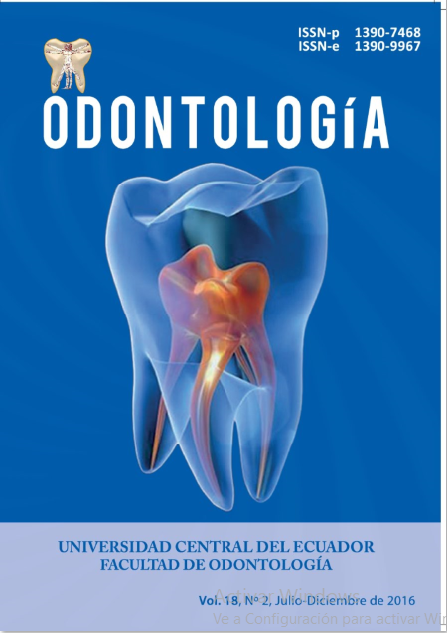Ludotherapy and Clown therapy in dental care for patient with prader-willi syndrome: Case report
Keywords:
Prader-Willi Syndrome, play therapy, obesity, handling (psychology)Abstract
The Prader-Willi Syndrome (PWS) is a complex genetic alteration affecting appetite, growth, metabolism, cognitive func-tion and behavior. It is characterized by low muscle tone, low height, incomplete sexual development, behavioral difficul-ties, and especially by chronic feelings of insatiable hunger and slow metabolism threatening life due to obesity. Changes in behaviour are very common and are related to the difficulty of dental treatment approach. We report the case of a 11-year-old patient, female, diagnosed with PWS, with high risk obesity and serious behavioural alterations. Clinically, she present-ed active caries lesions, periodontitis and dental extraction need. Conditioning for dental treatment was performed using techniques of ludotherapy and play therapy during 6 sessions, allowing the proposed interventions. It could be concluded that the use of both conditioning interventions decreased the anxiety facilitating the professional-patient bond, appearing as effective techniques for the outpatient care on pediatric patients dental control with severe behavioural alterations.
Downloads
References
Holm VA et al. Prader-Willi syndrome: Consensus diagnostic criteria. Pediatrics, 1993; 91:398-402.
de Almeida MQ, Cercato C, Rascovski A, Goldbaum TS, de Figueiredo DA, Matsuda M, Zilberstein B, Vi-llares SM, Halpern A. Results of biliopancreatic di-version in two patients with Prader-Willi syndrome. Obes Surg. 2005 Jun-Jul;15(6):901-4.
Cassidy SB, Schwartz S, Miller JL, Driscoll DJ. Pra-der-Willi syndrome. Genet Med. 2012 Jan;14(1):10-26.
Fridman C, Kok F, Koiffmmann CP. Síndrome de Prader-Willi em lactentes hipônicos. J. pediatr, 2000 maio/jun; 76(3):246-250.
Boran P, Tokuc G, Pisgin B, Oktem S, Yegin Z, Bos-tan O. Efeito da obesidade na função ventilatória. J Pediatr (Rio J) 2007;83:171-6.
Mesquita MLG, Brunoni D, Pina Neto JM, Kim CA, Melo MHS, Teixeira MCTV. Fenótipo comportamenal de crianças e adolescentes com síndrome de Pra-der-Willi. Revista Paulista de Pediatria, 2010;28(1): 63-9.
Koenig K, Klin A, Schultz R. Deficits in social attri-bution ability in Prader-Willi syndrome. J Autism Dev Disord 2004; 34:573-82.
Benarroch F, Hirsch HJ, Genstil L, Landau YE, Gross-Tsur V. Prader-Willi syndrome: medical prevention and behavioral challenges. Child Adolesc Psychiatr Clin N Am 2007; 16:695-708.
Goos LM, Ragsdale G. Genomic imprinting and hu-man psychology: cognition, behavior and pathology. Adv Exp Med Biol 2008; 626:71-88.
Bailleul-Forestier I, Verhaeghe V, Fryns JP, Vinckier F, Declerck D, Vogels A. The oro-dental phenotype in Prader-Willi syndrome: a survey of 15 patients. Int J Paediatr Dent. 2008 Jan;18(1):40-7.
Rosário DC, Risso SP, Matsumoto JB, Vicente BS, Barbério A, Pallos D. Aspectos genéticos e clínicos da Síndrome de Prader-Willi: revisão da literatura. Re-vista Biociências, 2015; 3(3):127-133.
Buiting K. Prader Willi Syndrome and Angelman Syndrome. Am. j. med. genet. C, Hoboken. 2010; 154(3):365-376.
Caldas Júnior ADF, Rodrigues VMDS, Caldas KU, Barros JADP, Cabral AMC, Souza MDFD. Síndrome de Prader Willi: relato de caso. Rev. cir. traumatol. bu-co-maxilo-fac. 2007; 6(1): 37-42.
Saeves R, Espelid I, Storhaug K, Sandvik L, Nordgar-den H. Severe tooth wear in Prader-Willi syndrome. A case-control study. BMC Oral Health. 2012 May 28:12:12.
Yanagita M, Hirano H, Kobashi M, Nozaki T, Yamada S, Kitamura M, Murakami S. Periodontal disease in a patient with Prader-Willi syndrome: a case report. J Med Case Rep. 2011 Jul 28;5:329.
Chilamakuri S, Nuvvula S, Sunkara N. Play therapy in pediatric dentistry. J Pediatr Dent 2014; 2:28.
Angotti R, Meucci D, Molinaro F, Bulotta L, Bindi E, Cerchia E, Vaccarella G, Messina M. In the era of “red nose”, can clown-therapy reduce the nursing sta-ff’s anxiety? Minerva Pediatr. 2015 Oct;67(5):452-4.
Bazopoulou-Kyrkanidou E, Papagiannoulis L. Pra-der-Willi syndrome: report of a case with special em-phasis on oral problems. J Clin Pediatr Dent. 1992 Fall;17(1):37-40.
Anavi Y, Mintz SM. Prader-Labhart-Willi syndrome. Ann Dent. 1990 Winter;49(2):26-9.
Greenwood RE, Small IC. Case report of the Prader-Wi-lli syndrome. J Clin Periodontol.1990;17:61–63.
Viardot A, Sze L, Purtell L, Sainsbury A, Loughnan G, Smith E, Herzog H, Steinbeck K, Campbell LV. Prader-Willi syndrome is associated with activation of the innate immune system independently of cen-tral adiposity and insulin resistance. J Clin Endocrinol Metab. 2010; 95:3392–3399.
Guideline on Behavior Guidance for the Pediatric Dental Patient. Pediatr Dent. 2015;37(5):57-70.
Felluga M, Rabach I, Minute M, Montico M, Giorgi R, Lonciari I, Taddio A, Barbi E. A quasi randomi-zed-controlled trial to evaluate the effectiveness of clowntherapy on children’s anxiety and pain levels in emergency department. Eur J Pediatr. 2016 Jan 12.[Epub ahead of print]
Manyande A, Cyna AM, Yip P, Chooi C, Middleton P. Non-pharmacological interventions for assisting the induction of anaesthesia in children. Cochrane Data-base Syst Rev. 2015 Jul 14;7:CD006447.


